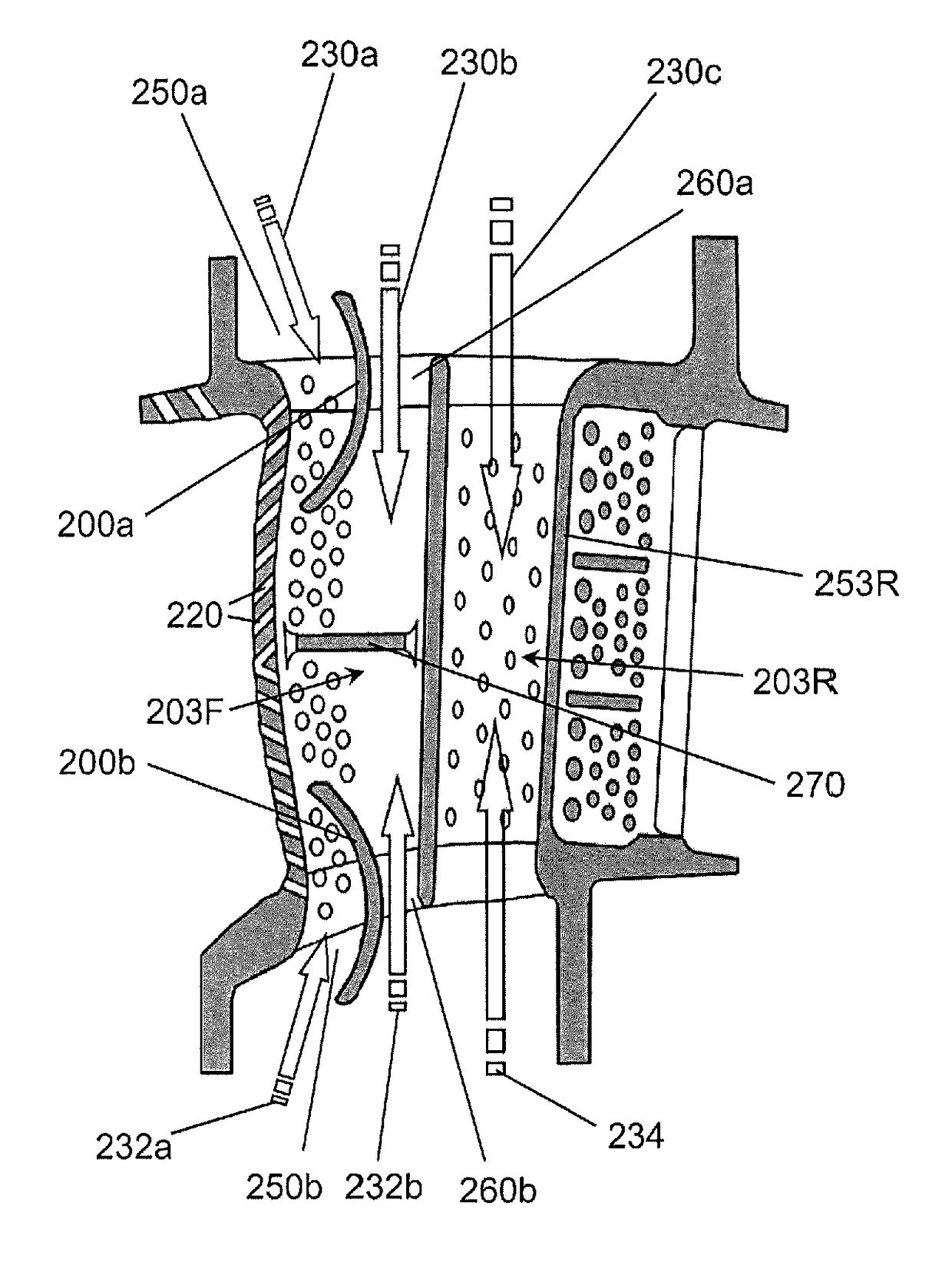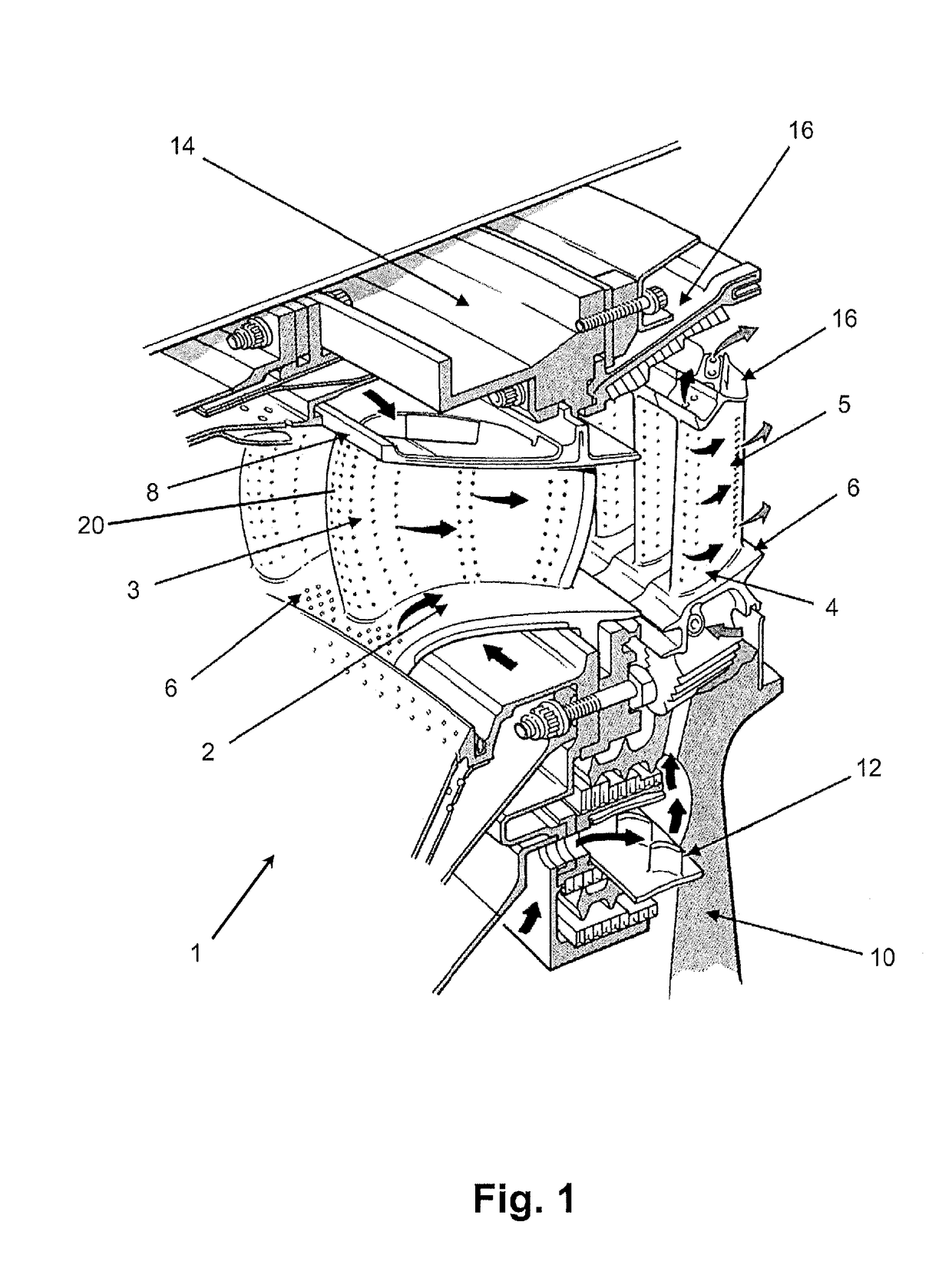Internal cooling of engine components
a technology of internal cooling and components, which is applied in the direction of machines/engines, stators, mechanical equipment, etc., can solve the problems of affecting the life of uncooled turbines, affecting the efficiency of the engine, and the cooling air from the compressor used to cool the hot turbine components is not used fully to extract work from the turbin
- Summary
- Abstract
- Description
- Claims
- Application Information
AI Technical Summary
Benefits of technology
Problems solved by technology
Method used
Image
Examples
first embodiment
[0093]In its simplest form, the invention is shown in FIGS. 5(a) and 5(b), which show diagrammatically the geometry of the new arrangement according to this embodiment. Mounted within the inlet portion of the chamber 103F is a partitioning element 100, which is in the form of a curved, arcuate or scoop-shaped plate or sheet (e.g. of the same or a compatible metal or alloy as used to cast the NGV side walls). The new partitioning element 100 divides the inlet portion of the cooling chamber 103F into two sub-chambers: a primary sub-chamber 150 which is located forwardly immediately adjacent the leading edge portion of the NGV (and thus adjacent the stagnation zone 80) and a secondary, rearward located, sub-chamber 160 which carries the remainder of the cooling air feed into the cooling chamber 3F. A sheet metal (e.g. planar) baffle plate 170 is located slightly below mid-span within the cooling chamber 3F. As shown schematically in FIG. 5(a), the partitioning element 100 extends a sho...
second embodiment
[0105]FIGS. 6(a), 6(b) and 6(c) show the invention, in which a HPT NGV aerofoil cooling arrangement comprises a dual-end cooling air feed supplying cooling air from both outboard 230 and inboard 232, 234 sources to the forward cooling chamber 203F. Mounted generally centrally within and across the width of the chamber 203F is a planar baffle plate 270. Mounted within the rear cooling chamber 203R is impingement plate 253R, adjacent the rear suction-side side wall of the rear chamber 203R. A first partitioning element 200a is provided in the outboard inlet portion of the forward chamber 203F (i.e. that fed from the outboard cooling air feed source 230) and a second partitioning element 200b is provided in the inboard inlet portion of the forward chamber 203F (i.e. that fed from the inboard cooling air feed source 232). Each partitioning element 200a, 200b thus defines a respective forward sub-chamber 250a, 250b, which are fed from, respectively, outboard 230a and inboard 232a sources...
third embodiment
[0109]FIG. 7 shows a third embodiment, which is a HPT NGV aerofoil cooling arrangement with a dual-end feed to a sheet metal insert tube 385a fitted into the forward cooling chamber 303F. There are provided an array of impingement holes in the leading edge wall of the insert tube 385a. The insert tube 385a also has a sheet metal (e.g. planar) baffle plate 370 located slightly below mid-span. The insert tube 385a is mounted in the forward cooling chamber 303F and supported therein by pin-fins 381 (like those labelled 481 in the alternative embodiment of FIG. 8) cast onto the internal walls of the NGV casting. Cooling air enters the insert tube 385a from one or both ends (inboard and / or outboard) and is then bled through an array or series of rows of holes in the insert tube 385a, impinging onto the internal walls of the casting, where the pin-fins 481 provide additional turbulent mixing of the cooling air. The cooling air then passes out of the various internal cooling sub- and mini-...
PUM
 Login to View More
Login to View More Abstract
Description
Claims
Application Information
 Login to View More
Login to View More - R&D
- Intellectual Property
- Life Sciences
- Materials
- Tech Scout
- Unparalleled Data Quality
- Higher Quality Content
- 60% Fewer Hallucinations
Browse by: Latest US Patents, China's latest patents, Technical Efficacy Thesaurus, Application Domain, Technology Topic, Popular Technical Reports.
© 2025 PatSnap. All rights reserved.Legal|Privacy policy|Modern Slavery Act Transparency Statement|Sitemap|About US| Contact US: help@patsnap.com



